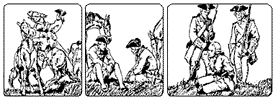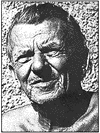
|
|
|
ZANIMLJIVO |
![[Drevni Hrvati u stripu]](adds/ad-hrvati.gif) |


Dedicated to the all Croatian artists, and to the all who fell in love with the comic strip art
 n May 12,
1935, in the Zagreb daily Novosti, the first strips of Maurović's
comic strip 'Vjerenica mača' (Bride of the Sword) appeared.
Based on a novel by Paul Fevale, its scenario was prepared by Krešo
Kovačić. n May 12,
1935, in the Zagreb daily Novosti, the first strips of Maurović's
comic strip 'Vjerenica mača' (Bride of the Sword) appeared.
Based on a novel by Paul Fevale, its scenario was prepared by Krešo
Kovačić. |
 ... from 'Vjerenica mača' |

Andrija Maurović |
With this, his first lenghtier work (up to now he drew cartoons for Koprive magazine, which mainly passed unnoticeably), Andrija Maurović introduced a talent of some sort and power of an artist with great potential. Immediately noticeable are the chief traits of Maurović's drawings,
which were, by dint of their uniqueness and recognizability, to
make him famous throughout the world: sharp contours, perfect mastery
of black-and-white contrasting, extraordinary visual, almost cinemastic,
dynamics. These qualities were part of his later works as well and
enabled him to develop his own comic strip language - the supreme
goal desired by all, but attainable only for the greatest creators
of the ninth art. |
... and then came the real beginning
| As soon as 'Vjerenica mača' came to
an end, Maurović ran 'Podzemna carica' ('Empress of the
Netherworld') in the Novosti, based on a novel by Alexey
Tolstoi, adapted by Krešo Kovačić. Maurović didn't terminate his work
for this Zagreb daily up until World War II. |
| His comics - 'Trojica u mraku', ('Three
Men in the Dark'), 'Sedma žrtva' ('The Seventh Victim'),
'Gospodar zlatnih brijegova' ('Master of the Golden Hills'),
and 'Sablast zelenih močvara' ('Ghost of the Green Swamps')
were justifiably proclaimed as the greatest realizations in his entire
opus and works whose significance extends far beyond Croatian limits. |
 ... from 'Ghost of the Green Swamps', Novosti 1937. |
|
But, if the appearance of Maurović's 'Vjerenica mača' meant
the beginning for the creation of Croatian comics, the appearance
of the first issue of Oko, an illustrated entertainment weekly
(July 6, 1936) was news of sorts for the publishing practice of
the day - comic strips thus definitely stepped onto Croatian
ground. In the latter half of 1939, Oko fell into a serious financial crisis, which didn't pass other comics of this period by, either. In search of saving grace, the paper merged with its competitor weekly, Mickey strip, and managed to survive another year under a new name. |
| Meanwhile, Maurović and Fuis had started thier
own paper (beginning of March 1938), the above mentioned Mickey
strip. Here Maurović introduced his new works, as well as reprints
of the old and sought-after ones, the brothers Neugebauer appeared
with their new works, and some young authors as well (Ferdo Bis, Zdravko
Sulić). Nevertheless, Mickey strip died in 1939, only to resurrect
sometime later, merging with the Oko weekly. |
 Norbert and Walter Neugebauer, 'Božanstvo Prašume', Veseli vandrokaš, 1939. |
For young authors, these were challenging times. The Neugebauer
brothers started an independent paper, Veseli Vandrokaš,
on October 5, 1938. Although prepared with much youthful vigor and
enthusiasm (Walter was 17 years old at the time), this paper didn't
fully fit the description of a real strip edition - therefore it
was extinguished very soon, after coming out for a mere 18 months.
After the merging of the two Zagreb papers, Mickey strip and Oko on October 6, 1939, a weekly by the name Mickey strip - Oko began its career. |
| But fate didn't favor this attempt either. Regardless of a nice anay of comics, this paper didn't manage to overcome the same material hardships faced by its predecessors. After only 30 issues, it was no longer being published ... Europe was already destroyed by World War II. In the middle of 1943, the Neugebauer brothers managed to start a weekly by the name of Zabavnik. This exceptionally interesting edition was being published for a full two years, displaying on its pages a whole line of quality comics, including some real masterpieces of the ninth art. Entering their most fertile phase, Walter and Norbert created works of unmatched value ('Patuljak Nosko', 'Gladni kralj', Mali Muk'), revealing thereby all their splendid talents. Their work represent the peak of humorous comics, which no one in the world, save for Disney, could show for themselves at the time. While Walter and Norbert were reaching their peaks with funnies, Maurović created for Zabavnik extraordinary stories of the adventure-realistic genre: 'Seoba Hrvata' ('Knez Radoslav'), 'Ahuramazda na Nilu', 'Grob u Prašumi', and 'Tomislav'. |
Summary
|
Issue 102 of May 1945 marked the end of the Neugebauer brothers' Zabavnik, thus closing a stormy chapter in the development of Croatian comics. And even though a mere decade had passed since Maurović's 'Vjerenica mača', this generation of young and talented authors (later named "the first generation") managed to establish a very firm foundation on which the comic strip in Croatia was to build an even brighter future in the postwar period. In a relatively short timespan, several valuable editions came out, and certain works by Andrija Maurović and the Neugebauer brothers are justifiably counted among the greatest realizations in the entire pre-war history of the world comic strip. |

|
Copyright © 1995-2000 Zvonimir Tošić. All rights reserved. Hosted by cro.net |